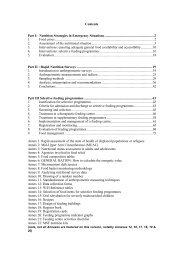UNHCR Handbook for Emergencies - UNHCR eCentre
UNHCR Handbook for Emergencies - UNHCR eCentre
UNHCR Handbook for Emergencies - UNHCR eCentre
Create successful ePaper yourself
Turn your PDF publications into a flip-book with our unique Google optimized e-Paper software.
emote border areas, are very vulnerable to<br />
extortion, abuse and sexual violence. A proactive<br />
approach is needed to ensure that<br />
protection needs are met.<br />
<strong>UNHCR</strong> considers a child to be:<br />
a person below the age of 18 years,<br />
unless, under the law applicable to the<br />
child, majority is attained earlier,<br />
as defined in the Convention on the Rights of<br />
the Child.<br />
Note that gender-related persecution can be<br />
considered a ground <strong>for</strong> recognition under<br />
the definition of refugee.<br />
<strong>UNHCR</strong>’s Guidelines on the Protection of<br />
Refugee Women, and Refugee Children:<br />
Guidelines on Protection and Care (see key<br />
references) are essential reading <strong>for</strong> those designing<br />
a protection programme. More in<strong>for</strong>mation<br />
on the procedures noted below is<br />
contained in section III of the <strong>Handbook</strong>, in<br />
particular chapter 10 on community services.<br />
48. Prevent protection problems <strong>for</strong> refugee<br />
women and children through good programme<br />
design in all sectors, including:<br />
❏ Obtaining a good knowledge of the population<br />
profile, especially the breakdown by<br />
sex and age;<br />
apple❏ Preserving the original family and community<br />
structures;<br />
apple❏ Consulting women on the design of the assistance<br />
programme, in particular on the<br />
design of the refugee camp and on the<br />
commodity distribution system;<br />
❏ Locating services so as not to expose<br />
refugee women to additional risk when<br />
using them;<br />
❏ Providing lighting in the camp especially<br />
along paths to latrines;<br />
❏ Ensuring an adequate number of women<br />
staff, particularly protection, community<br />
services and health staff;<br />
❏ Forming security patrols among the refugees<br />
themselves having the protection of<br />
women as a priority;<br />
apple❏ Providing training <strong>for</strong> police and military<br />
personnel on the rights of women and children,<br />
especially in circumstances where<br />
there is a heavy military or police presence;<br />
❏ Initiating tracing as soon as possible. Appropriate<br />
measures must be taken <strong>for</strong> identification,<br />
documentation, tracing, interim<br />
support and family reunion of separated<br />
children (see chapter 10 on community<br />
services <strong>for</strong> more in<strong>for</strong>mation on unaccompanied<br />
children);<br />
❏ Providing structured activities and primary<br />
schools <strong>for</strong> children (this can be important<br />
as a protection tool as it can help reduce<br />
recruitment into armed <strong>for</strong>ces);<br />
❏ Targeting assistance to remove the need<br />
<strong>for</strong> child labour;<br />
apple❏ Issuing birth certificates. Birth registration<br />
may be a prerequisite <strong>for</strong> obtaining nationality,<br />
enrolling in school and may be a vital<br />
tool <strong>for</strong> tracing. It can also be important in<br />
preventing military recruitment and other<br />
<strong>for</strong>ms of exploitation.<br />
Help Children by Helping the Family; Support<br />
Women to Preserve Family Unity.<br />
The single best way to promote the protection,<br />
well-being and safety of children is to<br />
support their families.<br />
Actively work to preserve family unity. Measures<br />
to promote the health and physical<br />
security of refugee women can help prevent<br />
separation of mother and child. A family,<br />
whose members have become separated or<br />
who are under serious stress, puts children at<br />
particular risk. Give priority to helping parents<br />
and other child care-givers meet the needs of<br />
their children. Also, recognize the parents'<br />
own needs. Families may need assistance in using<br />
their own coping techniques and rebuilding<br />
their support networks. Make every ef<strong>for</strong>t<br />
to preserve or reconstitute family help networks.<br />
Family groups wishing to live together<br />
should be helped to do so.<br />
Monitoring and Reporting<br />
49. Once immediate protection is secured,<br />
arrangements must be made to monitor the<br />
situation and ensure continuing respect of the<br />
rights of the refugees.<br />
50. Immediate, clear and regular reports of<br />
developments, action taken and intended to<br />
be taken are important, whether from the<br />
Field Officer to the Head of Office or from the<br />
latter to Headquarters. Guidance must be requested<br />
as necessary and Headquarters level<br />
interventions recommended as appropriate.<br />
See Annex 3 to chapter 8 on implementing<br />
arrangements, <strong>for</strong> a standard situation report.<br />
51. A prerequisite <strong>for</strong> intervention with a<br />
government, or <strong>for</strong> mobilization of international<br />
support, is accurate situation reporting.<br />
Protection<br />
2<br />
17



